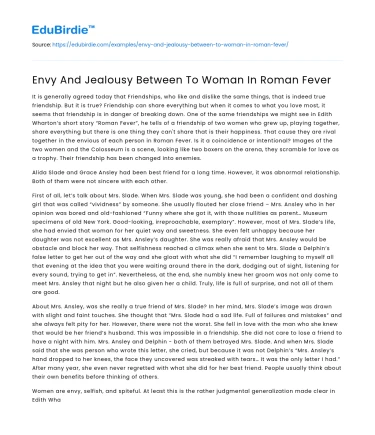Introduction
Edith Wharton's "Roman Fever," a short story first published in 1934, examines the intricate dynamics of envy and jealousy between two women, Mrs. Alida Slade and Mrs. Grace Ansley. Through a narrative set against the backdrop of Rome's evocative ruins, Wharton delves into the complex emotional interplay between these two characters, revealing how envy and jealousy can shape relationships and individual identities. This essay seeks to unravel the layers of envy and jealousy in "Roman Fever," illustrating how these emotions are intricately woven into the fabric of the protagonists' interactions. By analyzing specific instances and the psychological underpinnings of their rivalry, this essay aims to provide a comprehensive understanding of how Wharton uses these emotions to drive the narrative and develop her characters. Furthermore, addressing counter-arguments will highlight the nuanced portrayal of these emotions, reinforcing the thesis that envy and jealousy are central to the story's thematic core.
Envy as a Driving Force
Envy, distinct from jealousy, is characterized by a desire for what someone else possesses, often accompanied by feelings of inferiority and resentment. In "Roman Fever," envy is a pivotal force driving the tension between Mrs. Slade and Mrs. Ansley. Mrs. Slade, whose life was once filled with social engagements and the prestige of her husband's successful career, envies Mrs. Ansley's seemingly tranquil and fulfilling life. Wharton subtly portrays Mrs. Slade's envy through her inner monologues and observations, which reveal a deep-seated dissatisfaction with her own life. For instance, Mrs. Slade's reflections on Mrs. Ansley's daughter Barbara, whom she perceives as more vibrant and accomplished than her own daughter Jenny, underscores this envy. As literary scholar Carol Singley notes, "Mrs. Slade's envy is not just of Mrs. Ansley's past, but of her present and the potential future of her lineage" (Singley, 2015). This envy is not merely a passive emotion; it actively influences Mrs. Slade's actions, leading her to revel in the past deception she orchestrated, believing it granted her a temporary victory over Mrs. Ansley. However, the narrative reveals that envy is a double-edged sword, as it blinds Mrs. Slade to the true nature of her friendship and the reality of her own shortcomings.
Save your time!
We can take care of your essay
- Proper editing and formatting
- Free revision, title page, and bibliography
- Flexible prices and money-back guarantee
The transition from envy to the deeper, more complex emotion of jealousy is subtle yet significant in "Roman Fever." While envy focuses on the desire for what another has, jealousy involves a fear of losing what one already possesses. This distinction becomes evident as the story progresses, shifting the emotional landscape from envy to jealousy. Wharton intricately weaves these emotions, demonstrating how envy can evolve into jealousy, further complicating the relationship between Mrs. Slade and Mrs. Ansley. The interplay of these emotions is not only central to the narrative but also serves as a reflection of broader societal dynamics, where women's identities and worth were often tied to their relationships and familial roles.
Jealousy and Its Consequences
Jealousy, unlike envy, is a more possessive emotion, often rooted in the fear of losing something or someone to another. In "Roman Fever," Mrs. Slade's jealousy is largely centered around her late husband, Delphin, and the revelation of Mrs. Ansley's past relationship with him. The story reaches its climax when Mrs. Slade confronts Mrs. Ansley about a letter she believed she had orchestrated to embarrass her rival. This moment unveils the depth of Mrs. Slade's jealousy, as she grapples with the possibility that Delphin might have loved Mrs. Ansley more deeply. As Wharton writes, "I had Barbara," Mrs. Ansley responds, revealing that her daughter is the product of her night with Delphin. This revelation shatters Mrs. Slade's perception of victory and exposes the futility of her jealousy.
Jealousy, as portrayed in Wharton's narrative, has detrimental consequences for Mrs. Slade. Her obsession with undermining Mrs. Ansley blinds her to the reality of her own life, rendering her unable to appreciate the relationships and experiences she has. Literary critic Annette Benert argues, "Mrs. Slade's jealousy transforms her into a tragic figure, trapped by her own insecurities and misconceptions" (Benert, 2002). This jealousy not only strains her relationship with Mrs. Ansley but also leaves a legacy of bitterness and regret. In contrast, Mrs. Ansley's quiet confidence and acceptance of her past allow her to emerge from the confrontation with a sense of dignity and self-assurance. The juxtaposition of these two women highlights the destructive nature of jealousy and its potential to distort one's perception of reality.
Thus, jealousy serves as a catalyst for the story's dramatic revelations, offering a poignant commentary on the societal pressures women faced in maintaining relationships and social standing. Wharton's portrayal of jealousy is not merely a personal struggle but a reflection of the broader cultural expectations and limitations imposed on women during the era. By exploring the consequences of jealousy, Wharton underscores the importance of self-awareness and acceptance in navigating complex emotional landscapes.
Conclusion
In conclusion, Edith Wharton's "Roman Fever" masterfully explores the themes of envy and jealousy, using these emotions to unravel the complexities of female friendship and rivalry. Through the characters of Mrs. Slade and Mrs. Ansley, Wharton illustrates how envy can evolve into jealousy, driving individuals to destructive actions and ultimately revealing deeper truths about themselves and their relationships. The story serves as a timeless reminder of the dangers of allowing envy and jealousy to dictate one's actions and perceptions, highlighting the importance of introspection and self-awareness. By addressing counter-arguments and providing a nuanced portrayal of these emotions, Wharton enriches the narrative, offering readers a profound exploration of the human condition. Ultimately, "Roman Fever" invites readers to reflect on the ways in which envy and jealousy shape our interactions and the potential for growth and understanding that lies within each of us.






 Stuck on your essay?
Stuck on your essay?

